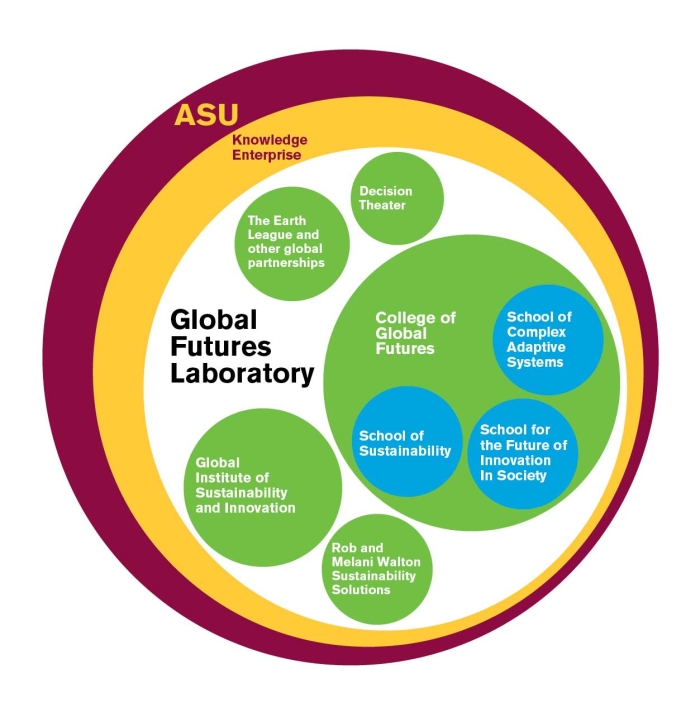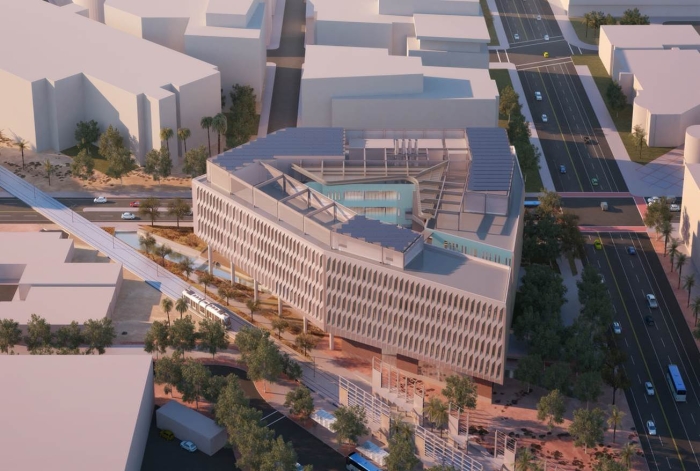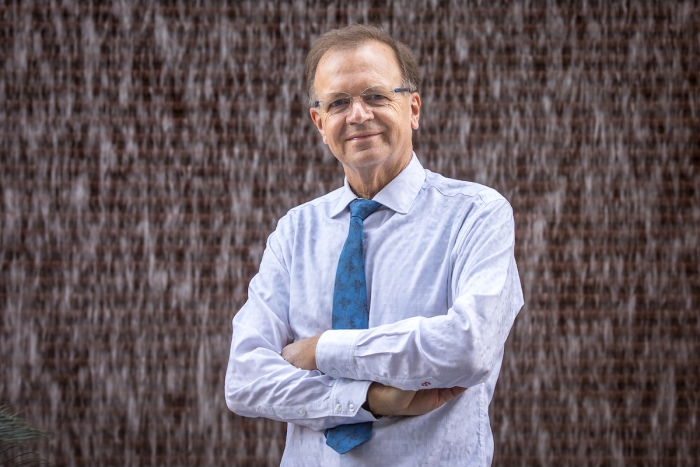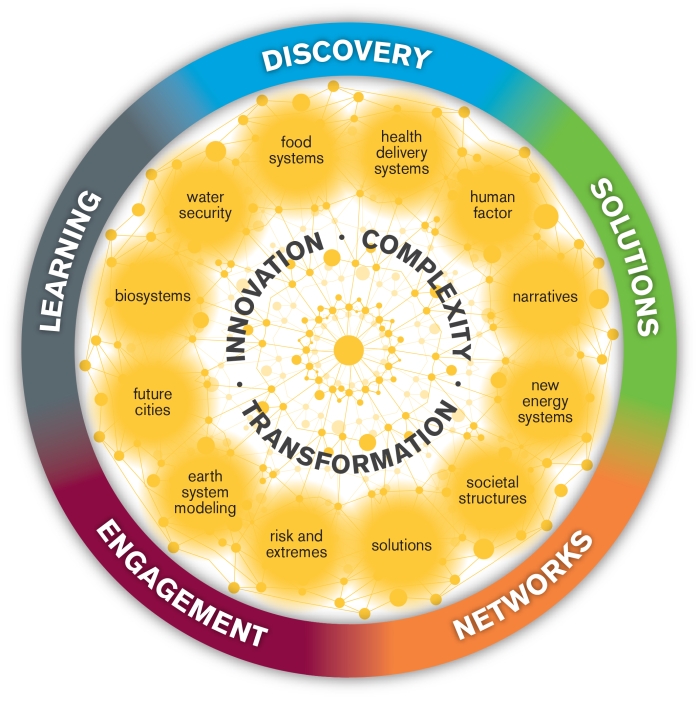ASU launches Julie Ann Wrigley Global Futures Laboratory with audacious goal: Transforming the world for a better future

Editor’s note: This story is being highlighted in ASU Now’s year in review. Read more top stories from 2020.
At a time of increasing challenges around the globe, successful responses and solutions depend on recognizing the complexity and interconnectedness of the Earth’s systems, both natural and societal. This includes confronting the accelerating dangers of a planet out of balance, the multiplicity of threats spurred by systemic failures — and embracing the enormous potential for humankind to set things right.
In response to current crises and driven by the belief in making positive, substantive advances, Arizona State University announced this week the launch of a laboratory dedicated to keeping our planet habitable and enhancing the options for future generations to thrive.
Such an undertaking might seem insurmountable. We have seen wildfires ravaging Australia. Storms flooding South Asia. Heat records in the Arctic. Drought-spurred refugees. Cities in conflict due to protest movements. All disasters magnified by the global pandemic, expanding the numbers of desperate and displaced people.
Throughout the past century, giant laboratories around the world were created by governments to commit massive amounts of money and brainpower toward defense, energy research and computing. They demonstrated the capacity to achieve large and targeted results on fast timescales. Yet the designs of these enterprises have been too limited in scope to pivot and address the complex dynamics between life on our planet and the systems that support it.
“We have decided it’s in the collective interest of humankind to build something that’s on the scale of a national laboratory in the United States, but not devoted to weapons and other defensive strategies — devoted to creative strategies and positive global futures,” said ASU President Michael Crow.
ASU’s Julie Ann Wrigley Global Futures Laboratory, building on a strong tradition of commitment to shaping a sustainable future for all humankind through innovation, will encompass a new college with three unique schools, as well as a major research institute and a practice arm devoted to solutions, each significantly enhanced by and integrated with global partnerships.
The Julie Ann Wrigley Global Futures Laboratory comprises a new college with three unique schools, as well as a major research institute and a practice arm devoted to solutions.
Its creation represents the next quantum leap in the evolution of ASU as one of the world’s premier centers for studies of sustainability and the future of life on our planet and the systems supporting it, an evolution that started in 2004. The emergence of the Global Futures Laboratory is the outgrowth of a 16-year effort to systematically build these fields of endeavor as anchors of ASU’s discovery, learning, problem-solving and engagement mission — and at a scale unmatched by any other university or research setting.
This includes construction of a headquarters for the laboratory, to be completed in December 2021, at a cost exceeding $200 million. The new Interdisciplinary Science and Technology Building 7 on the Tempe campus will be a high-performance research facility to foster an interdisciplinary approach to knowledge generation and leading-edge research across more than a dozen intellectual focal areas. The building — the largest research building on the campus — will be a hub for more than 550 faculty and scholars distributed across all ASU campuses and representing many disciplinary, interdisciplinary and transdisciplinary areas dedicated to the future of our planet, as well as for more than 1,300 students in the College of Global Futures.
As the world is confronted with an increasing number of crises and accelerating complexities, “we’d better figure out what to do,” Crow said. “We’d better figure out how to become more sustainable. We’d better figure out more and better innovations for the future of our society, looking at things in a completely new and different way. And we’d better understand how to manage complexity.”
An artist's rendering of the aerial view from the southeast of ISTB7, which is under construction now. Image courtesy of Grimshaw Architects/Architekton
Peter Schlosser, one of the world’s leading Earth scientists, is leading the effort.
“We are living in an era characterized by a planetary crisis of increasing proportions. Over centuries humankind has asked our planet to give more than it has to offer and driven it toward its environmental and societal boundaries. To address this crisis under extreme time pressure, we have to face the daunting task of mobilizing intellectual and material resources of proportions never seen before, and we have to do it now,” Schlosser said.
But ambitious goals can be achieved by teamwork combined with national will, Schlosser notes. In less than a decade, for example, society marshalled its resources to land a man on the moon.
At a time when countries around the world are seeking answers to confront the existential threats facing our globe, the Global Futures Laboratory is a bold response to the necessity of concentrating significant resources to make necessary advances.
This requires a holistic approach. For example, climate change is linked with energy because humans’ energy consumption causes the problem. It also changes the water cycle, which links directly with food production and food security. Both of those affect human health and existence.
In rethinking traditional approaches to academic work and public engagement — often too slow to ensure needed impact — the Global Futures Laboratory also aims to engage with speed and urgency to address the existential threats facing the planet and global society.
Crow calls the laboratory “a medical school for the Earth.”
COVID-19, the greatest crisis of the 21st century, has demonstrated that global challenges have left nations blindsided when faced with complex problems that affect all aspects of life.
COVID-19 erupted as a medical problem because of changes in the environment that made it easy for a pandemic to establish itself and spread globally. But it has had an immediate impact on society, restricting mobility, production, labor and the economy, plus a host of other problems no one saw coming. Ask anyone if they saw a national coin shortage looming last March.
Problems like these will require a transdisciplinary approach.
Peter Schlosser is the vice president and vice provost for Global Futures at ASU. Photo by Charlie Leight/ASU Now
“These are the challenges where we have to come together from different disciplines and look at an intellectual space that a single discipline cannot cover, that literally transcends each of these individual disciplines while at the same time not excluding them,” Schlosser said. The Global Futures Laboratory gives “us the ability to reach beyond any school, beyond any institute, throughout the entire university and very organically combine learning with discovery with solution with networking and engagement in one structure.”
Consider this: Decarbonizing the energy system will require the production of more renewable energy. In order to do that, societal acceptance needs to be widespread. And to be societally accepted, it has to be economically feasible and just.
“So that’s one of these problems where you can see how all individual elements that factor into a typical challenge we are addressing come together,” Schlosser said. “We have to understand the engineering, the impact on the environment, but also the economics of it, the acceptance of options for solutions and the human decision-making. The energy transition is just one of many examples of the problems we have to address, but without solving it we will put the planet onto the brink.”
The Global Futures Laboratory will be a hub for ongoing and wide-ranging exchange across all knowledge domains to address the complex social, economic and scientific challenges spawned by current and future threats from both environmental degradation and societal dysfunction. Home to solutions-based innovations such as technology for direct air capture of carbon, globally deployable microgrids, circular economy incubation, portable self-contained educational libraries and more, Global Futures Laboratory drives impact that creates economic opportunity and resiliency while protecting the environment and striving for societal stability and justice for all, across the globe.
The laboratory’s interdisciplinary strength will be based on five pillars:
- Learning: Exploring new ways of transmitting knowledge to diverse audiences according to their needs and priorities, including most prominently in the new College of Global Futures.
- Discovery: Leveraging the tools and expertise of transdisciplinary research institutes, centers and facilities across ASU, anchored by the Global Institute of Sustainability and Innovation, to generate new ideas and solve problems.
- Solutions: Working in networks and in close exchange with the people affected by problems to combine knowledge and develop solutions with urgency — such as with the Rob and Melani Walton Sustainability Solutions Service.
- Networks: Partnering with leading institutions around the world, such as the Earth League, to achieve a critical mass of intellectual resources to address challenges that are too big for any individual organization to solve alone.
- Engagement: Engaging with people who are affected by a problem to understand their needs, learn from their knowledge, share ideas and mobilize action.
The Global Futures Laboratory will be based on five pillars — learning, discovery, solutions, networks and engagement — with key topics being explored across disciplines.
The newly established College of Global Futures gives ASU the ability to understand and transform a complex system like the Earth by focusing on transformation, innovation and complexity. It will comprise three schools: the School of Sustainability, the School for the Future of Innovation in Society and the new School of Complex Adaptive Systems — with a goal of building a body of 5,000 students.
“The design of the College of Global Futures is intentionally transdisciplinary so that students participating in this new academic community graduate with the broad knowledge base and skills needed for the 21st century,” said University Provost Mark Searle. “Through coursework, research and applied projects with classmates and scholars from multiple disciplines, students will learn how to collaborate across sectors and design sustainable solutions that solve the complex challenges facing our globe.”
The college will be led by inaugural Dean Christopher Boone, a professor in the School of Sustainability and the School of Human Evolution and Social Change. He has served as dean of the School of Sustainability since 2013.
>> Read Dean Boone's vision statement“The College of Global Futures is dedicated to the principle that we can and should build a better future for everyone,” Boone said. “We can do so by elevating well-being everywhere, stewarding the planetary systems we depend on, and developing learning, discovery and partnership opportunities that are inclusive, fair and just. I am very excited about the extraordinary transdisciplinary approaches of ASU’s newest college. As part of the Julie Ann Wrigley Global Futures Laboratory, our faculty, staff and students will work together to tackle complex issues, develop creative, innovative and enduring solutions, and prepare the next generation of leaders to shape a bright and meaningful future for the planet and all its people.” for the college.
>> Learn about other leaders• The newly established School of Complex Adaptive Systems will be led by Manfred Laubichler as interim director. Laubichler is a President’s Professor in the School of Life Sciences and an external professor at the Santa Fe Institute, which is internationally known for its leading work in complexity science. • At the heart of the laboratory’s discovery pillar is the Global Institute of Sustainability and Innovation. The world’s leading laboratory for sustainability, it harnesses the creativity and knowledge of more than 550 experts working on solutions, engagement, education and research to enable better lives. • David Guston, Foundation Professor and founding and current director of the School for the Future of Innovation in Society, will be taking on a new role as associate vice provost for discovery, engagement and outcomes in the Global Futures Laboratory. Guston will link the research and engagement work of the laboratory with the College of Global Futures. Guston’s accomplishments as a leading scholar include fundamental work on the role of innovation for the future of global society. of the new College of Global Futures and the Global Institute of Sustainability and Innovation.
The laboratory’s namesake, Julie Ann Wrigley, is pleased that her vision of a sustainable world will be carried further into reality by ASU.
Wrigley described the laboratory as “an original commitment.”
“We’re stepping outside the box again,” Wrigley said. “We need to leapfrog, because humankind is facing so many critical issues on a planet that is increasingly overexploited. The planet will survive without us, but humankind may not make it. We have exceeded the carrying capacity of the Earth, and we are asking it for more than it has to give without damage to its life-supporting systems. The consequences are increasingly visible in more extremes across the globe. This is the time for that big leap. Peter Schlosser and Michael Crow came up with the concept of not only adding a new level of focus on our future, but a laboratory dedicated to it that reaches beyond the inside of the university to a global scale.”
COVID-19 exists because of our changed relationship with the natural environment, Wrigley said.
“The Global Futures Laboratory is equipping the university to a greater degree to look at the problems of the future,” she said. “And these problems are bigger than just the environment and must include the economical, intellectual, social and cultural functions and their close interconnectivity. And it reaches deep into the university as a whole. For example, one of the goals is to educate not hundreds of students, but many thousands. And through our global partnerships, impact millions in helping maintain a planet where future generations will not only survive but thrive. That’s the Global Futures lab."
Top photo by Pixabay
More Environment and sustainability

Rethinking Water West conference explores sustainable solutions
How do you secure a future with clean, affordable water for fast-growing populations in places that are contending with unending drought, rising heat and a lot of outdated water supply infrastructure…
Meet the young students who designed an ocean-cleaning robot
A classroom in the middle of the Sonoran Desert might be the last place you’d expect to find ocean research — but that’s exactly what’s happening at Harvest Preparatory Academy in Yuma, Arizona.…

From ASU to the Amazon: Student bridges communities with solar canoe project
While Elizabeth Swanson Andi’s peers were lining up to collect their diplomas at the fall 2018 graduation ceremony at Arizona State University, she was on a plane headed to the Amazon rainforest in…





